
2024 Winners of the 20th Annual Archie League Medal of Safety Awards
View our 2024 Awards book in UberFlip
View our 2024 Awards book in PDF
Alaskan Region: Wayne Harper, Anchorage ATCT (ANC)
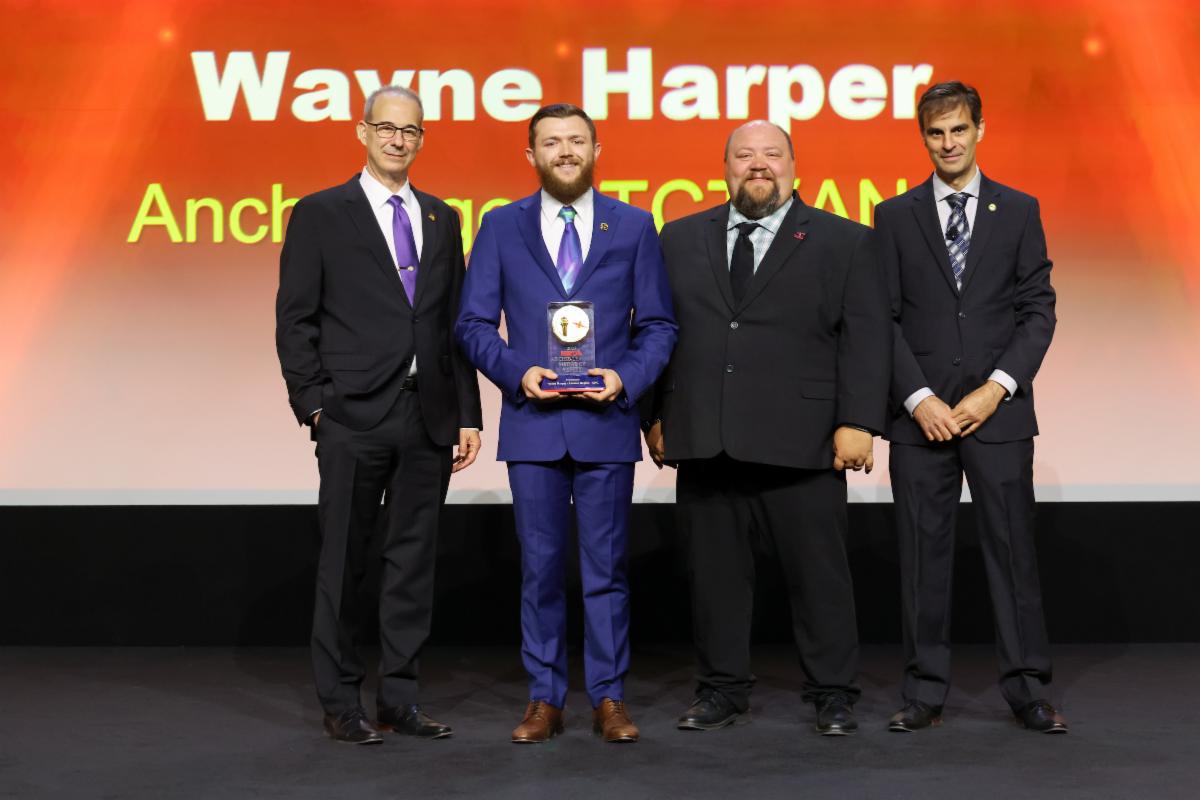
Written by Amanda Clinefelter Anchorage ATCT, (ANC)
The sun had set at Anchorage International Airport (ANC) on Feb. 1, 2024, with record-breaking snow accumulation for the year. Controller Wayne Harper was working the local and Lake Hood control positions. The airport was landing both parallel runways, 7R and 7L.
FDX9051, a McDonnell Douglas MD-11, had just landed on Runway 7R. Wayne instructed FDX9051 to “turn left at TWY G and hold short of 7L”, a routine operation in this configuration. The pilot read back the instruction correctly. Meanwhile, NAC2731, a Boeing 737, was on final for Runway 7L and quickly approaching the threshold. As FDX9051 exited Runway 7R, Wayne noticed that the position of FDX9051 looked strange for an aircraft holding short of Runway 7L. The crew of FDX9051 became disoriented with snow partially obscuring the runway lights, signs, and markings. The plane continued across the hold lines of Runway 7L. As soon as FDX9051 keyed up to verify the instruction, Wayne identified the uncertainty in the pilot’s voice. Wayne quickly pivoted to review the Airport Surface Surveillance Capability (ASSC) display and verify the position of both aircraft. He maintained his composure as he took quick action to clearly and concisely issue a go-around to NAC2731, who was now less than 1,000 feet from the Runway 7L threshold and less than 3,500 feet from FDX9051.
Wayne’s vigilance and quick action lead to a safe resolution, preventing a potential catastrophe. “It happened really quickly,” Wayne observed. He attributes his successful scan to his training, stating, “my training team really emphasized the scan, and I think that’s what saved the situation for me. I think while the ASSC would have gone off, I don’t know if it would have gone off in time to issue the go-around.”
Congratulations to the 2024 Alaskan Region, Archie League Medal of Safety Award Winner, Wayne Harper!
– Alaskan Regional Vice President Clint Lancaster
Watch the award presentation:
Highlights from this save:
Podcast below: Hear Owens, Rolofson, and Rosenbaum tell their story, in this episode of the NATCA Podcast.
Central Region: Anthony DeHaven, Cameron Haynes, Allison Healey, Tyler Spencer, Cody Wilkerson, and William Wyatt, Wichita Airport (ICT)
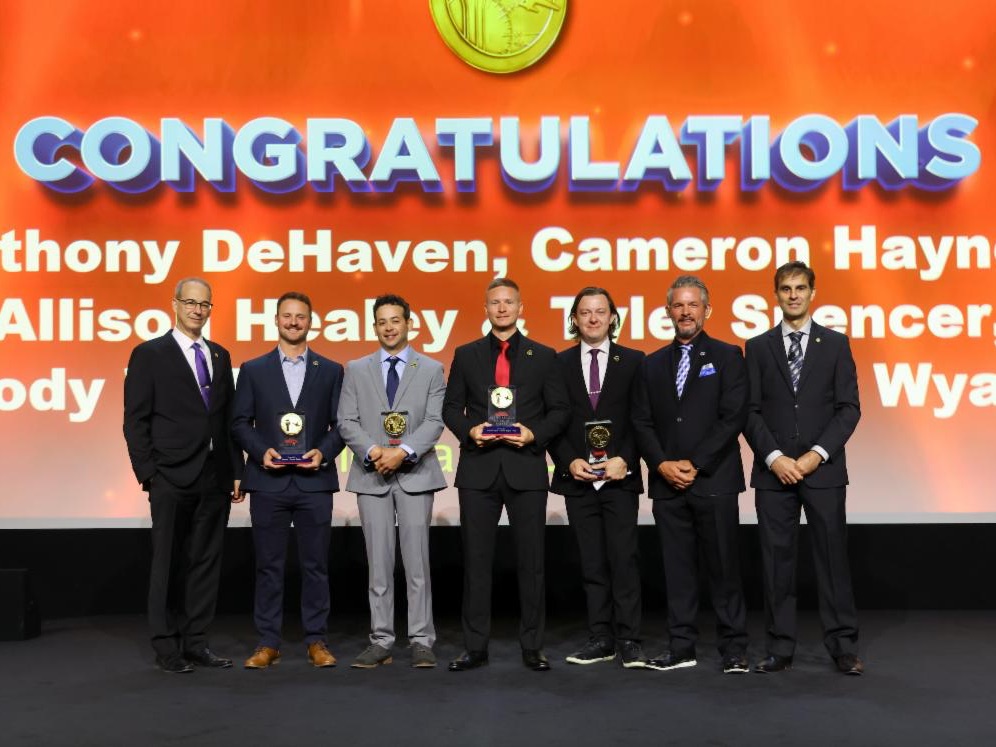
Written by Bryan Martini, Sioux Gateway Airport (SUX)
The evening of Jan. 23, 2024, at approximately 7 p.m., ASTRA81, a K35R from Fairchild Air Force Base (AFB) (SKA) attempted to land at McConnell AFB (IAB) located on the southeast side of Wichita. ASTRA81 made several attempts on IAB’s Instrument Landing System (ILS) 01L approach, but all were unsuccessful. The crew, believing an equipment failure at IAB was to blame, decided to divert to Wichita Airport (ICT) and try the ILS 01L approach there. However, ICT also had particularly low ceilings of 200 feet and half mile visibility. The conditions were so poor, the ground was not visible from the cab at ICT.
ASTRA81 checked in with Tyler Spencer at Wichita Approach and stated they had only 30 minutes of fuel remaining. Hearing this, Tyler declared an emergency. As ASTRA81 continued to receive vectors, they were unable to receive the ILS. Tyler quickly switched them to the RNAV 01L, issued their approach clearance, then switched them to newly certified controller William Wytt in ICT Tower. As ASTRA81 relayed information to William, it became clear that they were unaware of their position, so William decided to issue climb out instructions and handed them back off to approach for another attempt.
Cameron Haynes, who was in charge in the tower, was relieved from position and headed straight for the TRACON to be of further assistance there. Allison Healy and Cody Wilkerson searched for airports within 100 miles that had better weather conditions. As Tyler recounts, “…everybody upstairs was doing anything and everything, coming up with ideas, looking up airports, trying to get a hold of another tanker.” Unfortunately, ASTRA81 was unable to accept airborne refueling.
ASTRA81’s next attempt was unsuccessful. They were unable to get stabilized on the approach despite William issuing them mileage off the centerline, with guidance from Tony DeHaven who drew from his military experience with surveillance approaches. Tyler recounted, “it came to a point, after the second attempt, where I thought if he’s going to crash, we want him to crash close to the runways because it’s such a residential area, and the pilot can’t see the ground. He doesn’t know if he’s going to be landing on houses or a school. We wanted to get as close to the runway as possible for the best possible outcome.”
While on their third attempt at the approach, William issued ASTRA81 mileage from the airport every few miles to aid the flight crew in maintaining their descent profile. Thankfully, ASTRA81 was able to land. During a post-landing phone call, the pilot revealed that their IFR equipment was not functional, and they had only 12.8 minutes of fuel remaining. They were unsure if they would have been able to make another approach attempt.
Congratulations to the 2024 Central Region, Archie League Medal of Safety Award Winners, Anthony DeHaven, Cameron Haynes, Allison Healey, Tyler Spencer, Cody Wilkerson, and William Wyatt!
– Central Regional Vice President Aaron Merrick
Watch the award presentation:
Highlights from this save:
Podcast below: Hear tell their story, in this episode of the NATCA Podcast.
Eastern Region: Brian Bernhardt, and Jason Wilson, Philadelphia ATCT/TRACON (PHL)
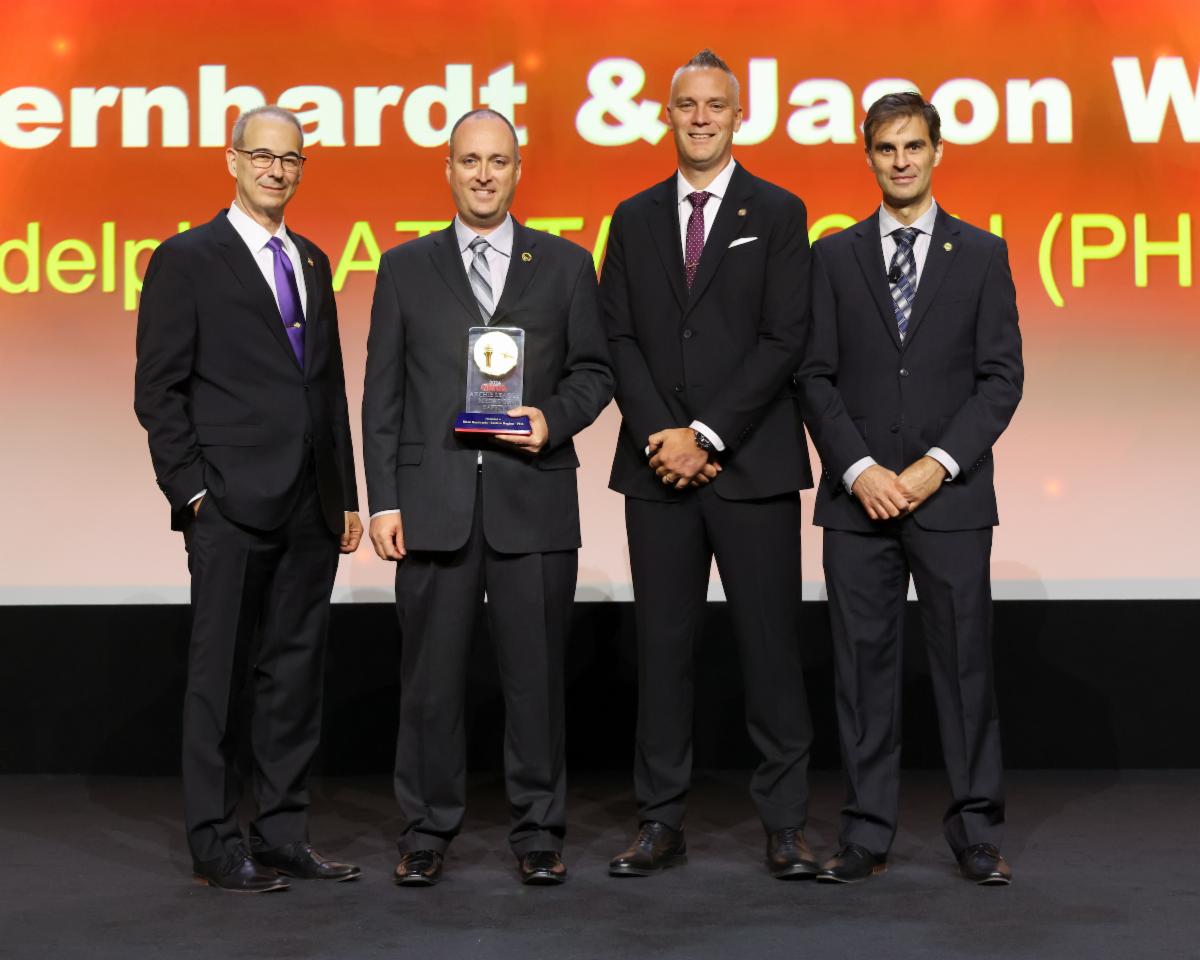
Written by Jaymi Steinberg, Washington Center (ZDC)
On the evening of Feb. 18, 2024, Brian Bernhardt, a 23-year veteran controller, was working Philadelphia Approach (PHL) whilst his colleague, Jason Wilson, worked in the tower cab. Visual Flight Rules (VFR) conditions prevailed which turned out to be very fortunate. Among the aircraft under Brian’s control was N47PG, a Grumman Tiger operating under VFR. Everything appeared normal when suddenly N47PG keyed his mic and said, “Philadelphia Approach, N47PG declaring an emergency…” Brian couldn’t have anticipated what the pilot said next. N47PG stated, “I just somehow knocked my glasses off my face, and I can’t find them. I’ve got pretty poor vision. I can kind of make out instruments, but I’m going to need radar vectors, I think, possibly to Philly, maybe Philadelphia International would be the best one if possible. I could definitely use some help up here.”
Brian, a pilot himself, quickly worked through what the pilot’s limitations and capabilities were. He provided assistance for both vertical guidance and a series of no-gyro vectors that eventually led to N47PG being properly aligned with Runway 9R at PHL. Due to the concern that having the pilot change radio frequencies would add extra complications to an already stressful situation, it was decided that the pilot would be handed off from Brian in radar to Jason in the tower without a frequency change. Brian said, “All I had to do was point the pilot to the airport and give him to Jason, he’s the one that talked him down and really did the hard work to get him on the ground.”
Jason, a veteran controller with 22 years’ experience, watched out the window for N47PG. Upon assuming the frequency he said, “I took over, started talking to the guy and just telling him what I was seeing and trying to coach him down.” Even though Jason has not flown in years, he has some pilot experience which helped him navigate the situation. Jason helped the pilot to maintain his surroundings and awareness. The pilot was able to focus on aviating and getting the plane toward the runway. Jason inquired if the pilot could distinguish Runway 9R and the pilot replied, “I see lights, but I can’t distinguish the runways from one another.” Luckily, the taxiways at PHL are 75 feet or more wide, which is more than a Tiger needs to land. Jason said, “We have the parallel taxiways also cleared for you so just find a set of parallel lights and line up for them.” Using the approach lights, Jason helped the aircraft identify 9R. As the aircraft stopped on the runway the relative deficit of vision became apparent. A follow me vehicle was dispatched, but its lights among the many other airport lights in the darkness made the pilot unable to distinguish the vehicle. The pilot was eventually able to get on a taxiway and find his eyeglasses.
This save is a testament of teamwork, which was expressed well by the pair’s nominator, Nathan Hendrickson (Philadelphia ATCT, PHL), “This was an awesome display of teamwork, composure, and air traffic skill.”
Congratulations to the 2024 Eastern Region, Archie League Medal of Safety Award Winners, Brian Bernhardt and Jason Wilson!
– Eastern Regional Vice President Mike Christine
Watch the award presentation:
Highlights from this save:
PODCAST: Hear discuss this event.
Great Lakes Region: Matthew Adair, Jennifer Harshbarger, and Michael Phillips, Columbus ATCT (CMH)
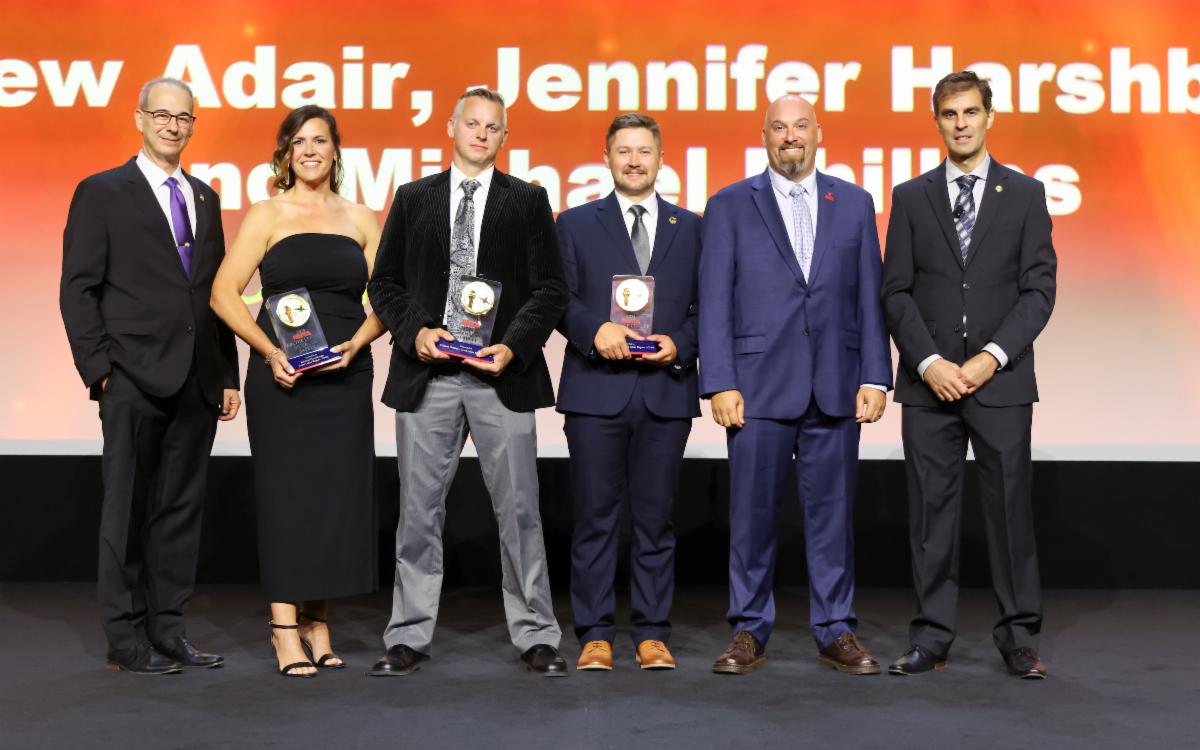
Written by Sarah Simek (Grand Forks ATCT, GFK)
On Oct. 16th, 2023, controller Mike Phillips was working the Columbus ATCT (CMH)’s Approach Control Middletown sector. It was a light traffic day with low ceilings covering most of central Ohio, when a call from Cincinnati Approach informed Mike of an aircraft coming to him that had reported the loss of a generator.
When N2274X, a Cessna Super Skymaster, checked in, Mike immediately took action and offered an alternate airport for landing and assessed the need for further assistance for the pilot. N2274X accepted the change to land at Dayton airport, and Mike provided current weather conditions and PIREPs for the area.
Soon after this exchange, N2274X’s Mode-C started to read zero and radio communication started to become difficult as the aircraft’s electrical system seemed to be failing. Through all the unknowns of the situation Mike continued to keep communicating headings, Minimum Vectoring Altitudes (MVAs), and coordinates with the Cincinnati controller to ensure the airspace surrounding N2274X remained clear of other traffic.
Mike, assisted by Controller-in-Charge, Matt Adair, worked through multiple attempts to help N2274X join the final approach course while the pilot struggled to maintain navigational control of his aircraft. At that point, N2274X reported his altitude, which was below the MVA for the area, and Mike immediately declared an emergency for the aircraft.
With limited options in a less-than-ideal situation, the controller team fell back on training and experience and decided to commence with an Airport Surveillance Radar (ASR) approach. Mike reminded the pilot what the standard rate of turn was and began issuing no-gyro turns onto the final approach course for Dayton Airport.
Soon after N2274X got established on final, the pilot reported, “N2274X has the runway in sight.” A landing clearance was given, and the pilot was able to land safely at Dayton Airport. Throughout the entire exchange, flight data controller Jennifer Harshbarger provided assistance and coordination that enabled Mike to provide service to the pilot with no distractions so the full focus could be on getting him on the ground safely as soon as possible.
Mike, Matt, and Jennifer’s experience and teamwork came together that day in October to provide a positive outcome to a bad situation. Great Lakes Regional Vice President Drew MacQueen said it best, “Throughout the entire exchange they never gave up or stopped working to find more options, while keeping the workload simple for a pilot trying to navigate an aircraft that was working against him. The team went above and beyond to make sure N2274X made it safely on the ground at Dayton airport that day.”
Congratulations to the 2024 Great Lakes Region, Archie League Medal of Safety Award Winners,
Matthew Adair, Jennifer Harshbarger, and Michael Phillips!
– Great Lakes Regional Alternate Vice President Dean Von Almen
Watch the award presentation:
Highlights from this save:
Listen below as Allan recounts the full story on an episode of The NATCA Podcast.
New England Region: Sarah O’Brien, and Hanan Wiseman (Boston TRACON, A90)
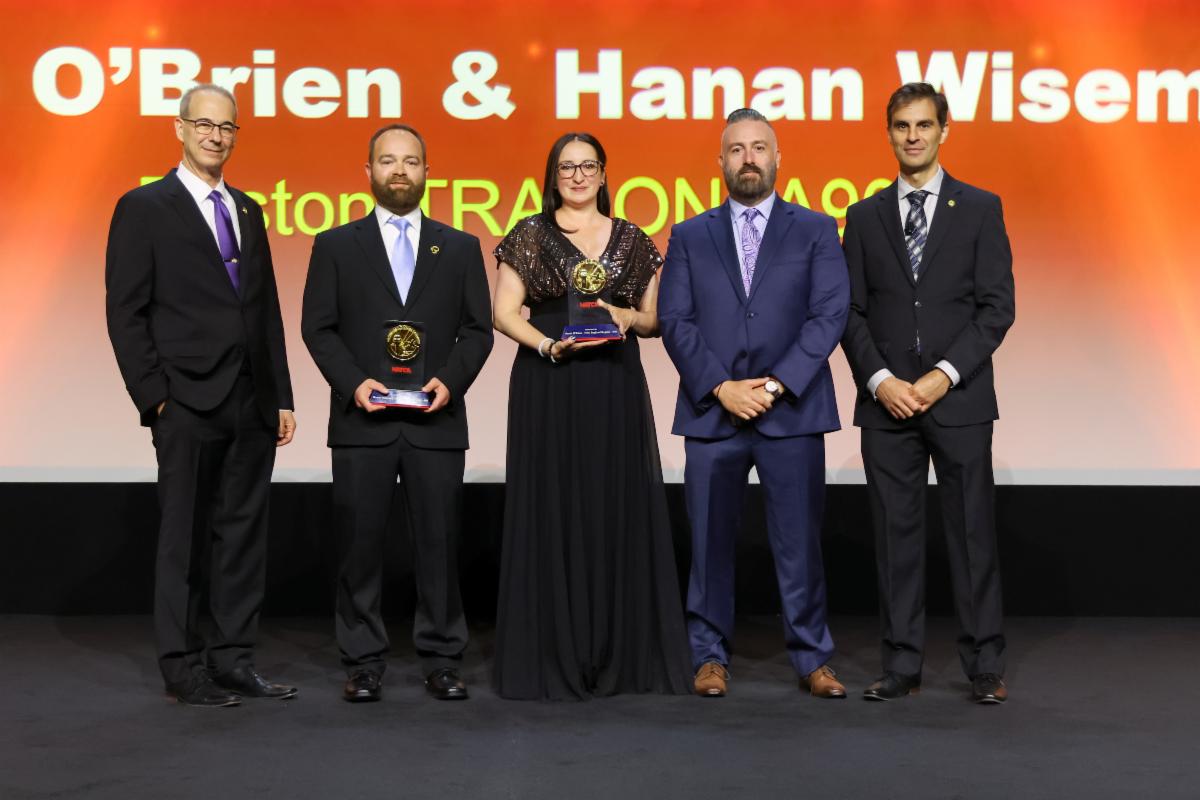
Written by Shannon Lyman, Boston Center (ZBW)
It was a clear September evening in 2023 and N6453H, a Cessna 182 Skylane, was flying under visual flight rules (VFR) at 6,500 feet, southwest bound in the Boston Bravo airspace. Initially, the pilot of N6453H was in contact with Sarah O’Brien (Boston TRACON, A90) who was working the Boston Departure position. At approximately 5:10 p.m., Sarah was no longer receiving radio communications from N6453H. At first, she didn’t think much of it, as that happens from time to time with VFR aircraft, so she handed radar control of the aircraft that had no radio communications off to Hanan Wiseman (Boston TRACON, A90), who was sitting next to her working the Bedford Sector.
The aircraft continued flying southwest bound and, as the Cessna was just west of Bedford Airport (BED), both Sarah and Hanan noticed the aircraft spiraling and descending in altitude. At that moment, their efforts to contact the pilot increased to help provide assistance to the pilot.
Hanan quickly switched to the emergency frequency, 121.5 mHz to establish communications with the pilot of N6453H and to change to his frequency. He then enlisted the help of a pilot who had just departed BED and was in the vicinity of the distressed aircraft, but as he was doing so, N6453H checked on Hanan’s frequency.
When N6453H checked on Hanan’s frequency using a handheld radio they had on board, the pilot noted that he had lost all electricity and was looking to return to Beverly Airport. However, Hanan suggested an alternative course of action, believing that was safer for an aircraft without electrical power.
With Sarah assisting, Hanan declared an emergency on behalf of the aircraft and coordinated with BED to have N6453H land on Runway 11, which was in the opposite direction of their current flow. Hanan was given approval from Bedford Tower, provided vectors to the pilot towards the airport, and cleared N6453H to land on Runway 11 at BED. The pilot landed safely thanks to the quick actions of Hanan and Sarah.
“Teamwork in air traffic is huge. It makes a big difference when you’re working next to someone you trust and work well with. Especially when it comes to VFR traffic, it is helpful to have an extra set of eyes looking out for you. In emergency or time sensitive situations, two people working through it and being able to tag-team any coordination that needs to be done as well as being able to monitor multiple frequencies makes a difference,” noted Sarah. Hanan emphasized, “Safety of the flying public is why we exist, so it’s everything to me.”
Congratulations to the 2024 New England Region, Archie League Medal of Safety Award Winners, Sarah O’Brien and Hanan Wiseman!
– New England Regional Vice President Kevin Curtiss
Watch the award presentation:
Highlights from this save:
Listen below as Allan recounts the full story on an episode of The NATCA Podcast.
Northwest Mountain Region: Jordan Smith (Denver TRACON, D01)
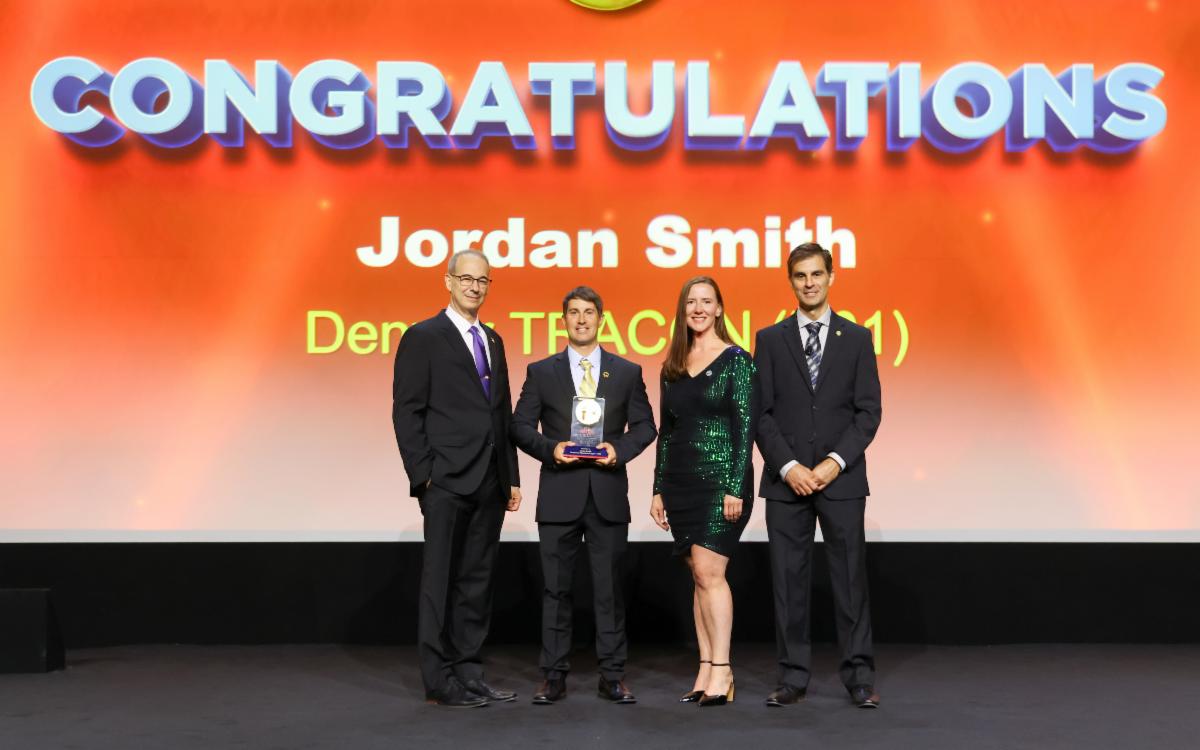
Written by Brittney Armbrust, Colorado Springs ATCT (COS)
Jordan Smith (Denver TRACON, D01) arrived at work around 5:30 a.m. on April 7, 2024, expecting a normal Sunday morning shift to end his work week. As it turned out, this would not be just a normal shift. Jordan was working a combined position, covering both West and South departures along with the satellite sector for Denver/Centennial ATCT (APA) and Broomfield Jefferson County ATCT (BJC). Traffic was light with VFR conditions and gusty winds from the west.
Southwest Airlines Flight 3695 departed Denver Airport (DEN) and checked in with Jordan. The pilot requested to level at ten thousand feet and a heading off the departure procedure because they thought they might have hit something on climb out. Jordan accommodated. However, the pilot quickly came back to declare an emergency and requested to return to land at DEN. Jordan’s instincts and training kicked in and he cleared them back to the airport and started coordinating with the tower to stop west and south departures.
The flight crew wasn’t sure of the nature of the issue, just that the cabin crew and passengers had expressed that something was coming off the right wing near the engine. The engine seemed to be running fine, but the aircraft was structurally damaged. Jordan immediately recognized that this wasn’t just a run-of-the-mill emergency
The pilot said they would need a few minutes to run checklists and figure out a plan to land. The traffic management coordinator was working right next to Jordan and suggested they land on Runway 26 with the gusty winds. The pilot decided they wanted to land on Runway 25 to try and avoid a crosswind issue. Jordan advised that he thought Runway 26 might work better, as it was closer. The pilot agreed, and Jordan started moving aircraft around to get them in that direction. Jordan cleared the path for them and let them know he was ready for them to turn when they were ready. SWA3695 turned on the base leg to land and the pilot advised it wasn’t going to work. They were going to need a no-flaps landing and the length didn’t work. They were going to require the 16,000-foot runway, 34L.
With no hesitation, Jordan told them, “No problem, we will start coordinating for that.” He started to move other aircraft around for the new plan. The pilots asked if Jordan could coordinate with the tower for emergency vehicles, and Jordan let them know they were already at the runway and ready for them. Jordan got SWA3695 back over the airport and set up for 34L. Once the pilots advised the runway in sight, he cleared the aircraft for the visual approach to Runway 34L and told them to contact the tower. SWA3695 landed on 34L shortly after without further incident.
Congrats to Jordan Smith on his Archie League Medal of Safety Award. The Northwest Mountain Region is proud to call you their own. Thank you and the team at D01 for your commitment to safety. Your professionalism is admirable.
Congratulations to the 2024 Northwest Mountain Region, Archie League Medal of Safety Award Winner, Jordan Smith!
– Northwest Mountain Regional Vice President Stephanie “Steph” Winder
Watch the award presentation:
Highlights from this save:
PODCAST: Listen to a conversation with below.
Southern Region: Steven Brader, Nashville ATCT (BNA), William Mitchell,Nashville ATCT (BNA), and Jaime Romaker, Nashville ATCT (BNA)

Article by Amy Sayers, Fort Lauderdale ATCT (FLL)
On March 1, 2024, N715MW, a BEECH 36 Bonanza was enroute to Smyrna Airport (MQY) from Cisco, Texas (GZN) on a Visual Flight Rules (VFR) flight plan with flight following. Josh Wilks, the pilot of N715MW, established radio communications with Jaime Romaker, a controller at Nashville ATCT (BNA), and was on track to land at his intended airport. While inbound, a controller familiar with the weather at MQY called Jaime and advised her that the weather was likely not going to be clear enough for a VFR aircraft to land.
Jaime advised the pilot of N715MW of the updated weather report. The pilot stated that he had about 45 minutes of fuel left and asked if they could find him a better place to land. With the surrounding airports reporting low ceilings, Jaime asked the pilot if he was Instrument Flight Rules (IFR) capable, but the pilot responded that he was not.
Jaime immediately started looking for alternate destinations. BNA was reporting Visual Meteorological Conditions (VMC) and the initial plan was to land at BNA airport, which was approximately 25 miles northeast. While N715MW was on his way to BNA, the weather deteriorated and landing at BNA was no longer an option. There were no airports reporting VMC conditions in the local area. The airports that were reporting marginal VMC conditions were approximately 40 miles from N715MW’s current position. Considering that weather conditions were not guaranteed to remain VMC and the low fuel state of the aircraft, these options were a risky choice.
Jaime and the rest of the team started looking for a safe airport for N715MW to land. They decided on Shelbyville Municipal Airport (SYI), which was about 49 miles south of the aircraft’s position at the time.
While N715MW made his way to SYI, the weather at John C. Tune Airport (JWN), which is 11 miles northwest of BNA, became incrementally better, and weather reports from air traffic control indicated that there was a chance that a VFR aircraft would be able to make it through the cloud layer. Jaime gave N715MW a vector towards JWN and then conducted a relief briefing with BNA member Will Mitchell.
After assisting Jaime from the coordinator position for several minutes, Will was familiar with the plan and was easily able to take over the position.
Will is a private pilot with both commercial and instrument ratings, and upon assuming the Departure Radar West position, he discussed the current options with N715MW. It became clear that, even with breaks in the cloud layer, N715MW was going to have to descend through instrument meteorological conditions (IMC). The initial plan that Will and the pilot agreed to was to make a slow spiral descent over the JWN airport until the airport was in sight. He talked the aircraft through each step of the process and worked to create a rapport with N715MV’s pilot.
Once N715MW was over JWN, N715MW started their descent in a large, slow spiral pattern over the airport. Despite being in a descent for several minutes, the pilot had only descended 400-500 feet. Will continued to advise the pilot what he was seeing on the radar and instructed N715MW to continue to descend. After observing N715MW inadvertently climbing, Will advised the pilot to level off and to fly straight and level. Realizing the spiral descent wasn’t viable, they devised a new plan with straighter lines and slow, easy turns. Josh began descending at 300 feet per minute with Will’s guidance.
Will asked if the ground was visible, but N715MW reported still being in the clouds. Anticipating that the pilot would soon see through the clouds, Will set up the aircraft for a stable approach. When the pilot reported being able to see the ground, Will verified that the pilot had the airport in sight and then cleared N715MW to land. JWN airport had been anxiously awaiting the arrival of N715MW and had held all traffic in anticipation of his arrival. N715MW landed safely thanks to the work of Steven, Will, and Jaime.
Through the combined expertise and quick thinking of the Nashville ATCT team, a potentially dire situation was managed effectively, ensuring the safety of N715MW and its pilot.
Congratulations to the 2024 Southern Region, Archie League Medal of Safety Award Winners, Steven Brader, William Mitchell, and Jaime Romaker!
– Southern Regional Vice President Dan McCabe
Watch the award presentation:
Highlights from this event:
PODCAST: Listen to a conversation with about this event.
Southwest Region: Amanda Alcantara, James Chipman, Daniel Keefe, Bryen Waltjen, and Jeremy Willard
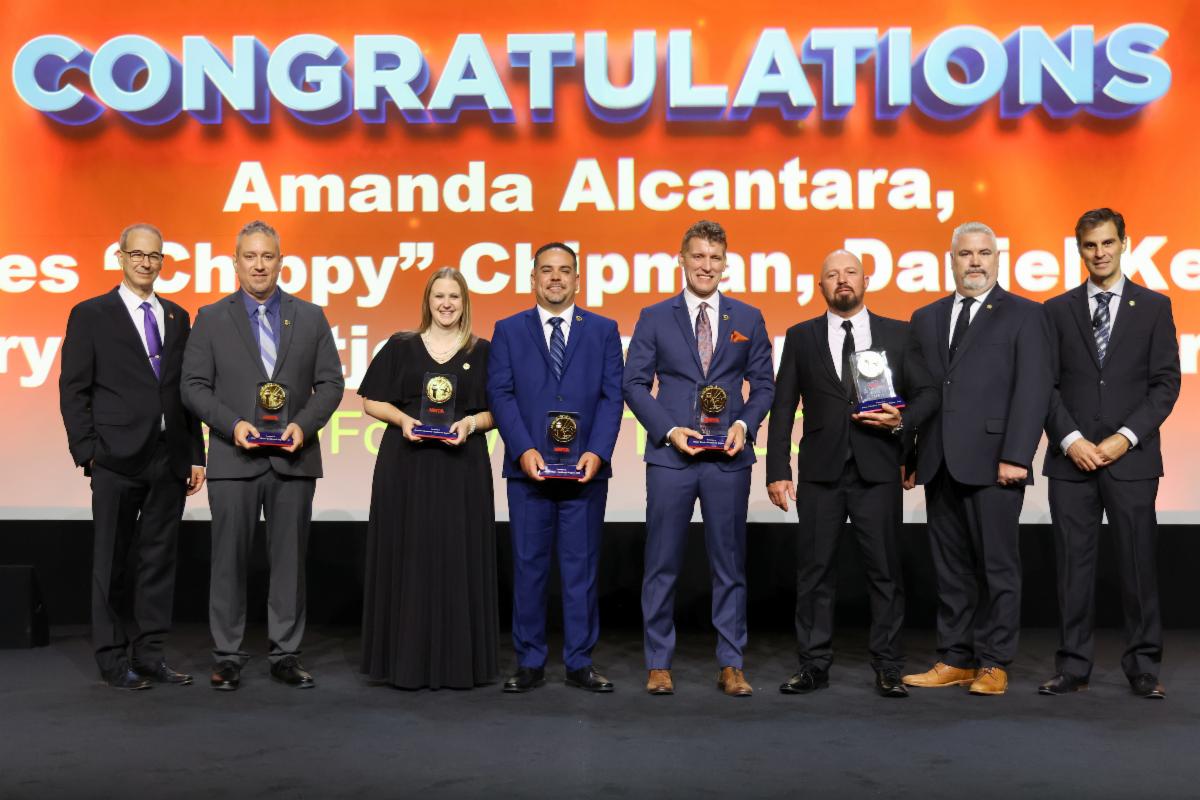
Written by Mary Ann Hall (Houston TRACON, I90)
On a seemingly ordinary day, Dallas North (DN) position accepted a radar handoff from Fort Worth ARTCC (ZFW) for N814DB, a VFR BE58, destined for McKinney Airport (TKI). However, just a few minutes after checking in, the pilot reported a critical engine problem.
“What can I do to help you?” James “Chippy” Chipman inquired, only to receive the alarming confirmation that the situation was dire. The pilot reported they just lost an engine, maybe two. Chippy jumped into next gear knowing time is of the essence. While keeping a calm demeanor, he pointed out the nearest airport, Short Stop (8TA5), six miles away from the aircraft’s current destination.
In the background, Daniel Keefe and Jeremy Willard, both working as Controllers-in-Charge in the TRACON, along with Flight Data Controller Amanda Alcantara, were gathering information about various airports for potential landing options. Since the aircraft was still outside of D10’s airspace, information about the small surrounding airports was not readily available to the controllers. The three controllers acted swiftly locating pertinent information and facilitating communication to ensure that Chipman had the necessary data to guide the pilot during a time when every second counted.
Meanwhile, Bryen Waltjen, who was managing traffic at Addison, provided support by handling the flow of air traffic, allowing Chipman to focus entirely on the emergency aircraft. The teamwork displayed was essential as the emergency unfolded.
Despite Chippy’s best efforts to guide N814DB’s descent, the aircraft passed Short Stop Airport, never getting the runway in sight. The team scrambled to locate other landing options. Chippy started vectoring N814DB to Caddo Mills Airport (7F3). Due to radio coverage and the BE58’s low altitude, communications with the pilot were sporadic. After telling the pilot the airport is at his 10 o’clock and six miles, Chippy received the response, “We don’t think we are going to make it.” Chippy remained calm giving the N814DB instructions, but the pilot never heard him.
In a remarkable display of coordination, Chippy requested assistance from WUP491, a nearby aircraft, to relay vital vectors to N814DB. This strategic move proved successful, and the pilot finally reported sighting Caddo Mills Airport, expressing hope that they could reach it.
Through WUP491, Chippy informed the pilot that emergency equipment would be standing by upon arrival.
After losing radar contact, SWA1559 relayed the heartening news that N814DB had landed safely. This successful outcome was a testament to the extraordinary efforts of Amanda, Bryen, Chippy, Daniel, and Jeremy, whose teamwork and commitment to safety made a significant difference in a critical moment.
“The actions of these five dedicated professionals exemplify the highest standards of safety and service in the aviation industry, showcasing the profound impact that teamwork can have in the face of adversity,” exclaimed NSW RVP John Bratcher, “Their exemplary performance not only ensured the safety of the flight in question but also reinforced the importance of communication, coordination, and collective responsibility in air traffic management. They truly embody the spirit of the Archie League Medal of Safety Award, and it is an honor to celebrate their achievements as the Southwest Region winners.”
Congratulations to the 2024 Southwest Region, Archie League Medal of Safety Award Winners, Amanda Alcantara, James Chipman, Daniel Keefe, Bryen Waltjen, and Jeremy Willard!
– Southwest Regional Vice President, John Bratcher
Watch the award presentation:
Highlights from this event:
PODCAST: Listen to a conversation with about this event.
Western Pacific Region: Devin Stankevitz, (Chino, CNO)
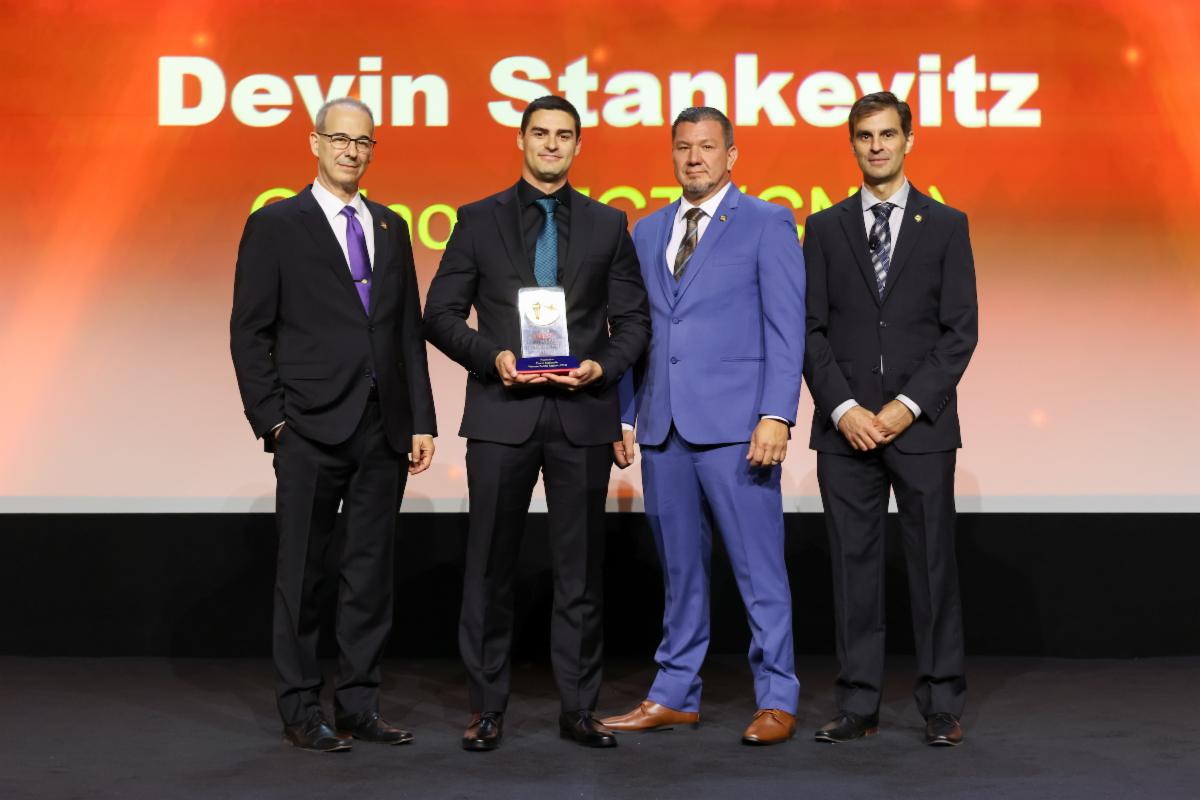
Article by Ariana Seimas (Fresno ATCT, FAT)
It was a typical Saturday morning at Chino Airport. Devin Stankevitz was managing a relatively busy opening shift as the Controller in Charge (CIC) and Local controller with Ground control combined, as the other Certified Professional Controller (CPC) was on break. Devin had a certified ground controller (local trainee) in the tower not on position. A group of six RV aircraft, Dawn Patrol Formation, known for performing in air shows, was preparing to depart for a local practice area. Everything seemed routine until one of the pilots reported fuel in the fuselage and needed to return immediately for landing.
Devin quickly and calmly responded to N628PV, giving him a right downwind entry to Runway 26R, then quickly offering the pilot an opposite direction landing to Runways 8L or 8R. Devin addressed the other aircraft in the pattern and safely had them make way for the emergency aircraft that needed an opposite direction landing. The ground controller quickly contacted the fire department and 911 dispatcher separately, as the crash phone system was temporarily out of service.
Devin’s experience and training kicked in, allowing him to clear the runway and taxiways promptly. His familiarity with similar situations, including a previous incident involving a Cessna running out of fuel, ensured he remained composed and efficient.
Devin credits the smooth handling of the emergency to effective communication and teamwork. The ground controller was crucial in managing the telephone and contacting emergency services, while nearby pilots, understanding the severity of the situation, followed instructions promptly to ensure a safe environment for the emergency landing.
The cooperative effort extended to the other pilots in the airspace. This collective effort ensured that the emergency RV could land safely without additional complications.
After the aircraft landed safely and taxied off the runway under their own power to their ramp, Devin continued managing the busy airspace, allowing the other planes to continue pattern work. Reflecting on the incident, he emphasized the importance of training and preparedness. While he was grateful for the recognition he has received for the Archie League award, Devin acknowledged that every air traffic controller is trained to handle such emergencies, highlighting the collective professionalism in NATCA and the FAA.
The incident reinforced several key lessons for Devin and his colleagues. First, the importance of maintaining calm under pressure cannot be overstated. Devin’s ability to stay focused and make quick, accurate decisions was crucial to the successful resolution of the emergency.
Secondly, the value of teamwork and effective communication was evident. The ground controller’s swift actions in notifying emergency services and assisting with air traffic management were vital. Additionally, the cooperation of other pilots helped ensure a smooth and safe resolution.
Congratulations to the 2024 Western Pacific Region, Archie League Medal of Safety Award Winner, Devin Stankevitz!
– Western Pacific Regional Vice President Joel Ortiz
Watch the award presentation:
Highlights from this save:
PODCAST: Listen to a conversation with these NATCA members.
Honorable Mention
Alaskan Region
Daniel “Dan” Parks, Juneau ATCT (JNU)
Central Region
Chris Cimino, Kansas City ARTCC (ZKC)
Andy Crabtree, Kansas City ARTCC (ZKC)
Eastern Region
Michael Chen, La Guardia ATCT (LGA)
Raymond Dahlstrom, La Guardia ATCT (LGA)
Brian Fook, La Guardia ATCT (LGA)
Ryan Hakim, La Guardia ATCT (LGA)
Jon Larson, La Guardia ATCT (LGA)
Jacqueline Leon, La Guardia ATCT (LGA)
Richard Romano, La Guardia ATCT (LGA)
Gurpreet Singh, La Guardia ATCT (LGA)
Vincent Urban, La Guardia ATCT (LGA)
Amber Wolff, La Guardia ATCT (LGA)
Liang Zhou, La Guardia ATCT (LGA)
Mustafa Gawhary, Potomac Consolidated TRACON (PCT)
Nicole Atchley, Philadelphia ATCT (PHL)
Gaetano Chetta, Philadelphia ATCT (PHL)
Corey Grafe, Philadelphia ATCT (PHL)
Justin Puizina, Philadelphia ATCT (PHL)
Onja Rizvi, Philadelphia ATCT (PHL)
Zach Scheeler, Philadelphia ATCT (PHL)
Gabe Stein, Philadelphia ATCT (PHL)
Adam Szablowski, Philadelphia ATCT (PHL)
Rob Vaughan, Philadelphia ATCT (PHL)
Joe Wagner, Philadelphia ATCT (PHL)
Brandy Willis, Philadelphia ATCT (PHL)
Great Lakes Region
Daniel Hodnik, Chicago O’Hare TRACON (C90)
Anthony Howard, Chicago O’Hare TRACON (C90)
Brian Roth, Chicago O’Hare TRACON (C90)
Brock Wishowski, Chicago O’Hare TRACON (C90)
Joshua West, Cleveland Hopkins ATCT (CLE)
Greg Williams, Cleveland Hopkins ATCT (CLE)
Mike Phillips, Columbus (OH) ATCT (CMH)
David McTigue, Pontiac ATCT (PTK) D21
Cory Shannon, Detroit Metro TRACON (D21)
Creighton Coble, FARGO/ Hector Field ATCT (FAR)
Justin Ragan, FARGO/ Hector Field ATCT (FAR)
Logan Reimer, Fort Wayne ATCT (FWA)
Travis Waits, Green Bay Austin Straubel ATCT (GRB)
Chris Wood Green Bay Austin Straubel ATCT (GRB)
Stephen Castor, Terre Haute ATCT (HUF)
Jeffrey Deyoe, Terre Haute ATCT (HUF)
James Pepper, Terre Haute ATCT (HUF)
Haakon Mathisen, Peoria ATCT (PIA)
Kevin Betz, Indianapolis ARTCC (ZID)
Ashley Hall, Indianapolis ARTCC (ZID)
New England Region
Lucas Brotzman, Boston TRACON (A90)
Craig Drobek, Boston TRACON (A90)
Josh Morgan, Boston TRACON (A90)
Nick Sonntag, Boston TRACON (A90)
Kristin Garcia, Boston TRACON (A90)
Brian Nena, Boston TRACON (A90)
Kristen Ward, Boston TRACON (A90)
Melissa Garcia, Portland ATCT (PWM)
Derek Weaver, Portland ATCT (PWM)
Scott Elms, Boston ARTCC (ZBW)
Rosilla Owen, Boston ARTCC (ZBW)
Northwest Mountain Region
Brandon Cook, Billings ATCT (BIL)
Calvin Shultz, Denver TRACON (D01)
Reese Sherman, Portland Oregon ATCT (PDX)
Josh Anderson, Denver ARTCC (ZDV)
Amber Kizer, Denver ARTCC (ZDV)
Stephen Boyer, Salt Lake City ARTCC (ZLC)
Gaelen Davis, Salt Lake City ARTCC (ZLC)
Stacy Granley, Salt Lake City ARTCC (ZLC)
Richard Watson, Salt Lake City ARTCC (ZLC)
Patrick Beerman, Salt Lake City ARTCC (ZLC)
Ligaya Corbitt, Seattle ARTCC (ZSE)
Evan Gwinn, Seattle ARTCC (ZSE)
Lindsay Williams, Seattle ARTCC (ZSE)
Region X
John McCormick, Engineer/Eastern Region (EEA)
Allen Schlimper, Engineer/Southwestern Region (ESW)
Ed Szczuka, Engineer/Central Region (ECE)
Southern Region
Chase Montgomery, Charlotte Douglas ATCT (CLT)
Justin Dobso, Greater Cincinnati ATCT (CVG)
Jeremy Escalante, Greater Cincinnati ATCT (CVG)
Michael Fullenkamp, Greater Cincinnati ATCT (CVG)
Lisa Griffitts, Greater Cincinnati ATCT (CVG)
Zachary Huck, Greater Cincinnati ATCT (CVG)
Jon St. Louis, Greater Cincinnati ATCT (CVG)
Marc Sumner, Fort Lauderdale ATCT (FLL)
Marquis Blackshear, Miami ATCT (MIA)
Christiann Cambridge, Miami ATCT (MIA)
Danilo Castillo, Miami ATCT (MIA)
Junior Denis, Miami ATCT (MIA)
Dayron Fernandez, Miami ATCT (MIA)
Fernando Fraticelli, Miami ATCT (MIA)
Michael Gottfired, Savannah ATCT (SAV)
Kacey Melanson, Savannah ATCT (SAV)
Hannah Steele, Savannah ATCT (SAV)
Jacob Belen-Wides, Savannah ATCT (SAV)
Angela Baker, Atlanta ATCT (ZTL)
Robert Blakemore, Miami ARTCC (ZMA)
Adam Jones, Memphis ARTCC (ZME)
James Nelson, Memphis ARTCC (ZME)
Paul Nelson, Memphis ARTCC (ZME)
Richard Rhodes, Memphis ARTCC (ZME)
Adam Helm, Fort Myers ATCT (RSW)
Southwest Region
James Chipman, Dallas/ Fort Worth TRACON (D10)
Richard Currie, Dallas/ Fort Worth TRACON (D10)
Andrew Holliday, Oklahoma City/ Will Rogers ATCT (OKC)
Jason Donovan, New Orleans Moisant ATCT (MSY)
Russell Kipker, New Orleans Moisant ATCT (MSY)
Devin Leblanc, New Orleans Moisant ATCT (MSY)
Scott Martinez, New Orleans Moisant ATCT (MSY)
Ryan Roberts, New Orleans Moisant ATCT (MSY)
Josh Sewell, New Orleans Moisant ATCT (MSY)
Bryan Stanke, New Orleans Moisant ATCT (MSY)
David Bricker, Albuquerque ARTCC (ZAB)
Western Pacific Region
Eric Stevens, Phoenix TRACON (P50)
Darius Antonio, Kalaeloa Airport/ John Rodgers Field (PHJR)
Sianna Lorenzo, Kalaeloa Airport/ John Rodgers Field (PHJR)
Jamie Macomber, San Diego/Linberg ATCT (SAN) (now SAV)
Salvatore Vicari, San Diego/Linberg ATCT (SAN)
Michael Warfel , San Diego/Linberg ATCT (SAN)
Lisa Bonfanti, Santa Barbara ATCT (SBA)
Jennifer Zepeda, San Jose ATCT (SJC)
Thomas Brautigam, Santa Ana ATCT (SNA)
Cau Hau, Santa Ana ATCT (SNA)
Justin Nitsch, Santa Ana ATCT (SNA)
John Pink, Santa Ana ATCT (SNA)
Gavin Stubbs, Santa Ana ATCT (SNA)
Photo Album
View our photo album from the awards banquet and CFS 2023


